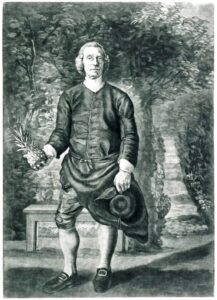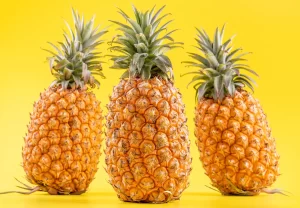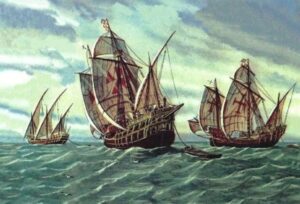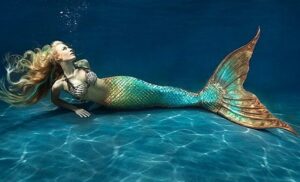Christopher Columbus
 In what is one of the funniest displays of “wealth” the pineapple was once carried around as proof that the one carrying it was a first-class citizen. Now, I can’t say that I think the tradition made any sense, but in 18th century England, pineapples really were a status symbol. Their very cost set the apart as something only owned by the very rich. Like many of the upper-class citizens of that era, they liked to flaunt their wealth to those less fortunate. So, those rich enough to own a pineapple would carry them around to signify their personal wealth and high-class status. They also adorned everything from clothing to houseware with the tropical fruit.
In what is one of the funniest displays of “wealth” the pineapple was once carried around as proof that the one carrying it was a first-class citizen. Now, I can’t say that I think the tradition made any sense, but in 18th century England, pineapples really were a status symbol. Their very cost set the apart as something only owned by the very rich. Like many of the upper-class citizens of that era, they liked to flaunt their wealth to those less fortunate. So, those rich enough to own a pineapple would carry them around to signify their personal wealth and high-class status. They also adorned everything from clothing to houseware with the tropical fruit.
Pineapples were first imported from South America to Europe by Spanish explorers starting in the 16th century. Though native to South America, pineapples made their  way to the Caribbean Island of Guadeloupe. It was in Guadeloupe that Christopher Columbus first spotted their spiky crowns in 1493. He and his crew took the pineapples back to Spain, where everyone loved how sweet this new, exotic fruit tasted. Unfortunately, because they were a tropical fruit, the pineapples wouldn’t grow in Spain. The only pineapples they could get their hands on had to be imported from across the Atlantic. It was time consuming and expensive undertaking, and often resulted in rotten fruit. From Spain, they then came to England. It was in England that the pineapple became the most prestigious fruit of the 18th century. European sailors brought it home as a sign of successful expedition and evidence of their prosperity. It also became a decorative piece on upper-class dining tables. When a pineapple was seen decorating the dining table of a home, you knew that the family had traveled places and
way to the Caribbean Island of Guadeloupe. It was in Guadeloupe that Christopher Columbus first spotted their spiky crowns in 1493. He and his crew took the pineapples back to Spain, where everyone loved how sweet this new, exotic fruit tasted. Unfortunately, because they were a tropical fruit, the pineapples wouldn’t grow in Spain. The only pineapples they could get their hands on had to be imported from across the Atlantic. It was time consuming and expensive undertaking, and often resulted in rotten fruit. From Spain, they then came to England. It was in England that the pineapple became the most prestigious fruit of the 18th century. European sailors brought it home as a sign of successful expedition and evidence of their prosperity. It also became a decorative piece on upper-class dining tables. When a pineapple was seen decorating the dining table of a home, you knew that the family had traveled places and  were either explorers or merchants with money, to afford the exotic fruit.
were either explorers or merchants with money, to afford the exotic fruit.
Because of its new-found fame, the pineapple grew to be very expensive. In the American colonies in the 1700s, pineapples were no less special. They were imported from the Caribbean Islands, and the pineapples that arrived in America were very expensive. In fact, one pineapple could cost as much as $8000…in today’s dollars. While they may have been a symbol of wealth, if you ask me, carrying one around would not be a wise way to show that wealth. It wouldn’t take long for that coveted fruit to go bad, and they all you had was the memory of the money spent and thrown away.

 Hallucinations are not an uncommon phenomenon after long periods of time at sea, but on January 9, 1493, explorer Christopher Columbus, sailing near the Dominican Republic, saw something in the water that was not a hallucination, rather just something he had never seen before. Columbus knew the sea. He was a sailor, but this was not something he had seen before, and he had no knowledge of such a creature to draw from.
Hallucinations are not an uncommon phenomenon after long periods of time at sea, but on January 9, 1493, explorer Christopher Columbus, sailing near the Dominican Republic, saw something in the water that was not a hallucination, rather just something he had never seen before. Columbus knew the sea. He was a sailor, but this was not something he had seen before, and he had no knowledge of such a creature to draw from.
Well, it seems like if we don’t have any idea of what something is, we tend to draw from fiction. That was what Colombus did when he mistakenly thought these creatures in the water were three mermaids. Well, of course, they weren’t mermaids, but manatees. Columbus was so sure of what he saw that he even described them in his journals as “not half as beautiful as they are painted.” Well, if you have seen a manatee, you will agree that they really aren’t what we would call “beautiful.”
Columbus had been at sea for six months, setting sail from Spain, heading across the Atlantic Ocean with the Nina, Pinta and Santa Maria, hoping to find a western trade route to Asia. Of course, we now know that his voyage, the first of four he would make, led him to the Americas, or “New World.” Maybe, it was his long months at sea that caused him to imagine mermaids. Or maybe seeing only water for so long and so far, made the manatees look different to him than they really did, although, he did not imagine them to be beautiful.
Mermaids are, of course, mythical half-female, half-fish creatures, that have graced the imaginations of seafaring cultures since the time of the ancient Greeks. “Typically depicted as having a woman’s head and torso, a fishtail instead of legs and holding a mirror and comb, mermaids live in the ocean and, according to some legends, can take on a human shape and marry mortal men. Mermaids are closely linked to sirens, another folkloric figure, part-woman, part-bird, who live on islands and sing seductive songs to lure sailors to their deaths.”
Those Mermaid sightings by sailors were most likely manatees, dugongs, or Steller’s sea cows…which became extinct by the 1760s due to over-hunting. Manatees are slow-moving aquatic mammals with human-like eyes, bulbous faces and paddle-like tails. There are three different species of manatee…West Indian, West African and Amazonian, and one species of dugong which belong to the Sirenia order. As adults, Manatee are typically 
 10 to 12 feet long and weigh 800 to 1,200 pounds…not exactly the sleek lines most people would associate with the feminine beauty of the mermaid. Manatees are plant-eaters, have a slow metabolism, and can only survive in warm water. Manatees live an average of 50 to 60 years in the wild and have no natural predators. However, they are an endangered species. In the United States, the majority of manatees are found in Florida, where scores of them die or are injured each year due to collisions with boats.
10 to 12 feet long and weigh 800 to 1,200 pounds…not exactly the sleek lines most people would associate with the feminine beauty of the mermaid. Manatees are plant-eaters, have a slow metabolism, and can only survive in warm water. Manatees live an average of 50 to 60 years in the wild and have no natural predators. However, they are an endangered species. In the United States, the majority of manatees are found in Florida, where scores of them die or are injured each year due to collisions with boats.
 My dad was always quite the kidder. He loved to joke around with his girls. He was also a bit of a history buff. He loved to travel, and in our many travels, his favorite thing was to stop at historical markers…especially the Oregon Trail. I’m pretty sure I have seen every marker for that one there is. Obviously, we didn’t have a good appreciation for some of his history information, like we should have, and might have today, but one historical fact that was of interest to all of my dad’s daughters was, Christopher Columbus. I’m pretty sure Christopher Columbus was my dad’s favorite historical character.
My dad was always quite the kidder. He loved to joke around with his girls. He was also a bit of a history buff. He loved to travel, and in our many travels, his favorite thing was to stop at historical markers…especially the Oregon Trail. I’m pretty sure I have seen every marker for that one there is. Obviously, we didn’t have a good appreciation for some of his history information, like we should have, and might have today, but one historical fact that was of interest to all of my dad’s daughters was, Christopher Columbus. I’m pretty sure Christopher Columbus was my dad’s favorite historical character.
I can’t say for sure when this story got started, but I can tell you that I was pretty young. The way the story went is this. Dad would begin by telling us that according to historical records, Christopher Columbus sailed the ocean blue in 1492…and you all know the rest of the story, right? Well, not exactly. You see, the story continues like this. Dad would tell us, “In reality, Chris didn’t discover America.” We would say, “He didn’t?” Dad would answer, “Nope, I did, but I was a nice guy, so I let Chris take the credit for it.”
We probably believed this tall tale early on, but after a while, we just went along with the joke because Dad liked it…and so did we. I think he always thought the idea of sailing across the ocean back in those days, in search of a new route or a new world, would be an exciting venture. He always had the heart of an adventurer, a fact that blessed his whole family with the ability to see many places. Dad loved to take us there…wherever there might be this time. And I think he always loved the idea of seeing beyond the normal range of vision…like a sailor looking out over the bow, or a mountain climber looking off across the mountain range from the top. It was a vision that would bless his whole family.
And I think he always loved the idea of seeing beyond the normal range of vision…like a sailor looking out over the bow, or a mountain climber looking off across the mountain range from the top. It was a vision that would bless his whole family.
I think my dad might have been a lot like Christoper Columbus. I think they both had a way of looking at things that goes deeper than average. A way of being able to pull the extraordinary from the ordinary. Maybe it was fantasy, but I don’t think there is anything wrong with a little bit of that in life.

